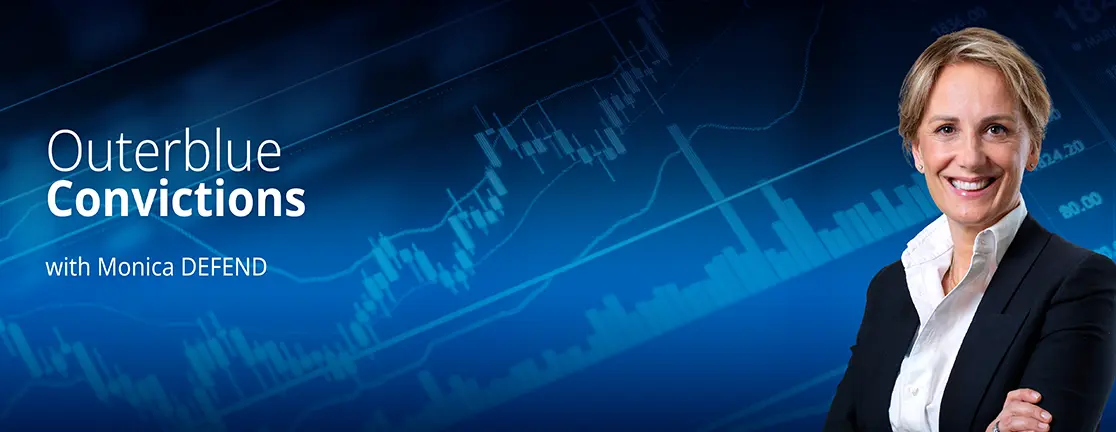In this month's review of the latest developments on the global economy and in financial markets, we focus on the seismic shifts that have been happening in Europe in the past few weeks, in particular, the historic spending package approved by the German parliament. Swaha Pattanaik and Monica Defend, Head of Amundi Investment Institute, catch-up to discuss the remarkable change in policy, and its implications for Germany and the wider Eurozone.
Will the rally in European markets continue and what opportunities does this open up on the equity and fixed income markets? The episode continues by examining the monetary policy outlook in Europe and how this compares to the projections for US growth.
Finally, we look at whether the Chinese stimulus package announcement has changed our view on the economic and market outlook for China.
This podcast is only for the attention of professional investors in the financial industry. Outerblue by Amundi. Welcome to Outerblue Convictions, Market Analysis and Asset Allocation Views.
Swaha Pattanaik: Hello and welcome to this regular Amundi podcast where every month we discuss what's happening in the global economy and financial markets. I'm Swaha Pattanaik, the Head of Publishing, and it's my great pleasure to welcome Monica Defend, the head of the Amundi Investment Institute. Hello, Monica. Great to have you on the podcast.
Monica Defend: Thank you, Swaha. And it's my great, great pleasure to be with you today.
Swaha Pattanaik: Well, last time Monica and I spoke, we discussed the implications of the slew of policy measures that were coming out of the United States. The news flow from that side of the Atlantic is still unrelenting, and we'll get to it a bit later. But I'd like to start today with some seismic shifts that have been happening in Europe. The continent's biggest economy, Germany, has managed to pull together a large spending package even before its next coalition government has been formed. Notably, Germany's self-imposed debt break won't apply to defence spending above 1% of GDP. And there's a special infrastructure plan that will be off-budget and can borrow as much as 500 billion euros over a dozen years. Monica, what's been the most remarkable thing for you about this German spending package and how much impact do you think it will have on growth in the coming year, both in Germany and the wider Eurozone?
Monica Defend: Well it is kind of a Copernican revolution I would say. The last time they went so bold on fiscal expansion was to finance the reconstruction after the reunification of Germany back in the early 90s and at that time inflation in Germany lifted up to 8%. So we know how obsessed they are in terms of inflation scares. And second, isn't it quite remarkable? And it gives the sense of national awareness and the need to change their industrial policy at a time where this industrial policy is still a kind of export-driven model, with still high energy dependence that has been challenged over the last three years. So, with an outgoing government, they've been able to change the constitution. Again, this is to me really a big shift they are making. In terms of results, first of all, let's see how this will be implemented, because we don't believe it is a story that will be deployed in the next six months, but we will have to wait until 2026 at best to see some impact on GDP and inflation patterns. As a result, then, we have been changing our forecast for now when it goes to growth and inflation in Germany.
Swaha Pattanaik: Thank you, Monica. I mean, markets never wait to get the results in GDP prints, even though, as economists, we may be a bit more cautious, and European stocks have been enjoying a renaissance in the past month, as the outlines of the spending package have become clearer and the various legislative hurdles have been jumped. What are they now pricing in? And what's your view on the outlook for European equities, given the valuations we've come to now?
Monica Defend: Well, as you said, the stock and the bond market have been reacting quite in a sparkling way with the European equities that eventually closed part of the undervaluation gap and that where have been registering remarkable inflows also from the US when it goes to investors' cross-border flows. The defense stocks had a remarkable rally and all in all I would say that the equity market went a bit ahead with optimism in what eventually will be delivered not only in Germany but at European level because honestly how financing the need will be accomplished is still not clear. When it goes to the bond market we have seen the Bund moving I think 50 basis points higher as a max and again there the bond market was kind of registering a sense of cautiousness in terms of inflation and sustainability of that burden that this will be eventually created in Germany and potentially in Europe.
Swaha Pattanaik: Thank you, Monica. Let's drill in a little bit more on the stock markets, which, as you said, have put in a really stellar performance. What are the opportunities that you see? You've mentioned defence and obviously that's the obvious one, but there are other things that are looking attractive as well in this environment.
Monica Defend: Well, definitely we do like a mid-cap from a valuation perspective. They are interesting and supported by good fundamentals, notably EPS growth. Probably they are a bit insulated from this trade war on tariffs that is still to be defined on/off, depending on the day. When it goes to sectors, we keep the preference for financials, notably banks and software, while maintaining the underweight on energy and autos.
Swaha Pattanaik: Thanks, Monica. You were talking about financials, banks in particular, and staying with the banks thing. What's happening in the fixed income market, in the bond market, with the shape of the yield curve, which is how the longer end of the bond market, how much that's yielding relative to the short end of the bond market, that's steepened and that's sort of good news in general for banks. Why is that playing out and how have you been looking at it and how much further this trend could go?
Monica Defend: I really think that this was really pricing in the potential for growth and inflation dramatic changes. This is why the movement was brutal in a few days, while we keep the idea that the ECB will be in the position to cut rates. So, we haven't changed our monetary policy outlook for now. And this will imply also some kind of a synchrony with the Fed that eventually we stay on hold until May. Having said that, duration-wise is a kind of a nightmare to be managed. Agile is the diplomatic word we are using, but we maintain for the time being this positive and constructive view on the EU duration. And we keep an eye on the steepeners, given how the curve has been moving now versus history, while we maintain a neutral stance on Treasuries.
Swaha Pattanaik: Great. Well, you mentioned agile. That's absolutely the right word when approaching the reactions to US policymaking. We're getting more clarity and purpose perhaps about the direction of travel on the European side for policymaking growth. How much uncertainty are you seeing on the other side of the Atlantic about American growth?
Monica Defend: Well, there is on the policy side, it's kind of chaotic and episodic. And this is really not helping when you need to pencil in and quantify projections. So unpredictability is the name of the game now. But what we are seeing is that this flip-flop policy eventually is harming confidence. And as such, we continue to see imports rising from the U.S. side just because people are anticipating higher tariffs ahead. And on the other side, on the corporate sector, this uncertainty is kind of carving a capital expenditure because investment is suffering when you don't know where the direction of travel will be. So if I compare where we were positioning versus consensus in terms of growth dynamic, we were staying on the left hand side, so quite cautious. We maintained for the time being our 2%, just to put a number for 2025 GDP expectations, having in mind that this might be open to some revision to the downside and that the deceleration that was already in our mind at the time we penciled the outlook is probably faster and accelerating.
Swaha Pattanaik: And so, we've already seen a rotation, sort of, as you mentioned, an interest more in Europe relative to the US. Where is the opportunity in the US market, in the stock market?
Monica Defend: Well, on the stock market, again, still we see the overvaluation at play. So we remain invested in the equally weighted index with a preference and a selection for those companies that still prove to have good fundamentals and good EPS perspective.
Swaha Pattanaik: Thank you. We haven't got much time left. I would like to close, however, on Asia, where it's obviously not on the seismic scale we saw and you outlined in Germany, but these Chinese authorities have also announced some stimulus. How is this feeding through to your views on the economic and market outlook for China?
Monica Defend: Well, the fiscal package that they have been announcing was confirming our idea when it goes to size, but was even better when we look at where the fiscal stimulus is going to be addressed, because eventually the kind of expenses will be run on a higher multiplier. Eventually then we are going to have a higher growth. This is the reason why eventually we revised our GDP expectation for 2025 from 4.1% to 4.4% for the year and 3.9% in 2026. The bottom line is that this fiscal impulse is going to counterbalance, in the short term, the higher tariffs. Having said that, still the Chinese authorities are using this fiscal package to pay off the current threat coming from the tariffs. That is an exogenous shock that is summing up to their internal need to rebalance the economy, which is in progress and is deploying in the direction we would opt for. So then how this translates in terms of investment consequences? We are neutral on Chinese equity and neutral on duration and in particular when it goes to equity we do have a preference for A-share and mid-cap.
Swaha Pattanaik: Great. Monica, unfortunately, that's all we have time for. So thank you very much for joining us and sharing your insights today.
Monica Defend: Thank you, Swaha.
Swaha Pattanaik: And thank you for listening to us. We'll be back next month with no doubt plenty to talk about. But in the meantime, you can check out our other podcasts on the Amundi Research Centre or on your preferred podcast platform. We'll catch you soon.
This podcast is only for the attention of professional investors as defined in Directive 2014-65-EU, dated 15 May 2014, as amended from time to time on markets and financial instruments, called MIFID II. Views are those of the author and not necessarily Amundi Asset Management SAS. They are subject to change and should not be relied upon as investment advice, as a security recommendation, or as an indication of trading for any Amundi products or any other security, fund units, or services. Past performance is not a guarantee or indicative of future results.










